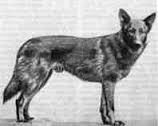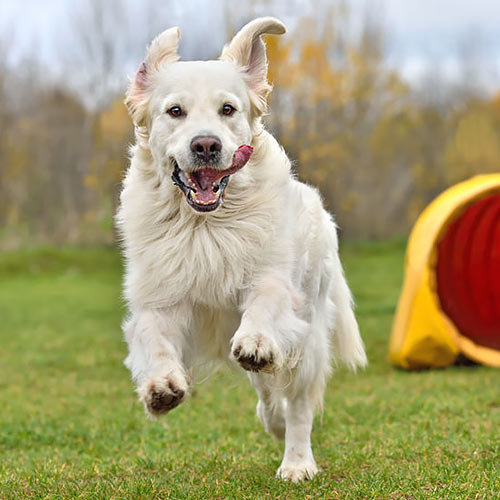Max Emil Friedrich von Stephanitz (December 30, 1864 – April 22, 1936) is credited for the development of the German Shepherd Dog. He was once a Captain in the German Cavalry. It was in the 1890’s that he was able to devote his time and talents to developing the “shepherd dog.” On April 22, 1899 Stephanitz, with his friend Artur Meyer and nine others, founded the Verein fur Deutsche Schaferhunde (S.V.). The SV developed a Breed Standard and a Breed Registry for the GSD. The SV is the largest registry in the world today. In 1901 a field trial was conducted which tested dogs in the areas of tracking, obedience and protection. Thus the Schutzhund trial was born. It was the idea of Stephanitz to employ the shepherd dog in other valuable tasks such as delivering messages, rescue work, sentry duties, police work, and as personal guard dogs. Some ideas were slow to take root, but eventually police departments, the military, and many others began to see the value of the Shepherd Dog. It was during WWI that the German Shepherd dog was noticed by many around the world and his popularity began to spread.
in the 1890’s that he was able to devote his time and talents to developing the “shepherd dog.” On April 22, 1899 Stephanitz, with his friend Artur Meyer and nine others, founded the Verein fur Deutsche Schaferhunde (S.V.). The SV developed a Breed Standard and a Breed Registry for the GSD. The SV is the largest registry in the world today. In 1901 a field trial was conducted which tested dogs in the areas of tracking, obedience and protection. Thus the Schutzhund trial was born. It was the idea of Stephanitz to employ the shepherd dog in other valuable tasks such as delivering messages, rescue work, sentry duties, police work, and as personal guard dogs. Some ideas were slow to take root, but eventually police departments, the military, and many others began to see the value of the Shepherd Dog. It was during WWI that the German Shepherd dog was noticed by many around the world and his popularity began to spread.
Below you will find many quotations of Stephanitz. A few are briefly edited for greater clarity without changing the context or meaning of the quote. The quotes are taken from The German Shepherd Dog in Word and Picture, written by Stepanitz in 1925, translated by J. Schwabacher, and reprinted in 1994 by Hoflin Publishing. It is hoped that some quotes will make you chuckle and that others will render a “light bulb moment.” They are given with a love for the Breed.
Max v Stephantiz on NATURE AND SERVICE of the German Shepherd
Know what your work is and do it.
Show me your dog, and I will tell you what manner of man you are.
There are few among us who can surpass him in fidelity and unconditional readiness to sacrifice himself.
Shyness is a result of faulty upbringing and breeding by man.
The place which a genuine shepherd dog guards, firm and upright on his four legs, is well protected indeed. “I warn the curious.”
The dog essentially thinks through his nose.
Just as man, the dog can express the various sentiments of the soul not only through the voice, … he also speaks through his eyes, through the altering expression of his face, through the carriage of his ears, and finally through the tail, which replaces his lack of arm- and hand- motions, and serves as a reliable “barometer” of the soul for the expression of every variation of feeling.
The working dog is trained to be very smart on the word of command, but he learns to understand very much more beyond it, if only his master will take the necessary pains with him.
I cannot remember a single shepherd dog who was not in love with children.
Untiring, always zealous for duty, always attentive, always ready to serve, such is the character of our shepherd dog.
The world-wide clamor for the Big Bank Account has been a curse for the shepherd dog as well as for other things.
The dog who is kept in the kennel…is no better than a beast caged for show.
I have…for a long time uttered warnings against keeping our shepherd dogs in kennels, and against a onesided breeding for beauty as opposed to efficiency. The shepherd dog is a working dog, he was born so, and only as such can he remain a “shepherd dog”; the dog which we value and love.
Max v Stephantiz on BREEDING the German Shepherd
The breeding of shepherd dogs is the breeding of working dogs; and this must always be the aim, or we shall cease to produce shepherd dogs.
That word “Sport” always means competition for the highest…, but this competition reaches its high-water mark in the show ring, which, just because they demand no real capabilities, …lead people only too easily astray to lay emphasis entirely on external shape and beauty, instead of on the substance which really matters.
Breeding on a large scale and in a kennel is the ruin of all sound shepherd dog breeding.
When it comes to breeding for business – which is never effected by dealers, at least not by official dealers -, the dog is only a business commodity and nothing more, and is bred and treated as such. There again we encounger another danger for the race. The dog is no longer bred from the point of view of his services to the race, but only because he has a certain market value. In other words, the direction of the breed is influenced no longer by the experts, but by the buyers. The buyer, however, is mostly an unsuspecting novice,….
The breeder on a small scale, one who works with one or two bitches, is the most suitable breeder for working dogs because he can care for his breeding animals and their progeny… and can produce sound strong animals that can be trained.
Breeding should never be made with animals that are not in work. The proof of the education of the dog for work is a necessity for admission for breeding, rather than Show honors, which afford a very misleading idea of a dog’s value for breeding.
Breeding worth and Show Worth are two fundamentally different things which need not have anything to do with each other; and further, a Show award must never be taken as a judgment of Breeding value, but only, and this too with reservations, as an opinion that a dog might possibly be suitable for breeding.
Efficiency for work must count for more with the shepherd dog breeder than the honors of the Show Ring.
Max v Stephantiz on BRINGING UP AND RAISING
Work is an indispensable necessity for the shepherd dog, if he is to be a shepherd dog: but kennel keeping will be a curse for him mentally and physically.
The confinement of a dog to a kennel, should be the exception, freedom the rule. The growing dog can only obtain this all-important development by excercise outside the kennel, no matter how long his run inside the kennel may be; the same holds true for exercsing the full grown dog as well.
Excuses are as plentiful as blackberries.
Max v Stephanitz on JUDGING THE SHEPHERD DOG
We have already agreed that our shepherd dog is a service dog, and that he must only be bred as a service dog. He must therefore … only be judged as a service dog. With service dogs, suitability ranks higher than beauty.
Shy weak-nerved animals are to be marked as injurious to the breed, even as over-bred dogs that are not true to the racial type…. In addition to a good shepherd dog expression, a lively disposition, a long solid well-knit body suitably proportioned for service, not spongy nor bulky, whose form guarantees a stretching out and swift gait, with powers of endurance are among the very first qualifications.
Physical size exercises great influence on ability to move, for with increase of size, weight grows more in proportion than the strength available for movement, which depends on the density of the muscles, and thereby suffers not only in that particular part of its service which demands endurance, but also in the suppleness of the body, and the power of making quick and sharp turns, sudden stops, and the surmounting of obstacles. Increased weight exercises as well a strong pressure on the supporting frame of the skeleton which affects the bones themselves, as well as the ligaments and muscles …. An excess of size is … an unserviceable feature for breeding (because) his powers of endurance, his speed and the smartness of his movements suffer in all circumstances. Giants are never nimble…. Such dogs then use themselves up quickly when they are eager and full of ardor. They are, however, generally, lazy and easy-going and for that very reason are already unfit for service.
We abominate overbreeding because it makes both body and soul unsuitable for work.
It is this humble working stock that possesses blood, life, fire and the shepherd dog soul.
Even the most perfectly built dog is of no use if he does not possess the incentive to give of his best and of his uttermost.
The coloring of the dog has no significance whatever for service; our shepherd dog accordingly is not bred for color. Coloring therefore is only a fad of the amateur and as such is often liable to changes of whim.
Max v Stephanitz on SCHOOLING AND TRAINING
A sound training does not aim at producing shy, broken slaves with no will of their own, nor machines whose efficiency depends on external impulses, it keeps itself within bounds, and, though checking the undesirable characteristics of the pupils, it subordinates its private predilections to a higher aim, and tries to produce creatures whose service, out of the their joy in their work, is perfect liberty. This training then must know how to awaken the inborn capacities, and to develop them, and must, in addition, tone down what is superfluous, strengthen what is weak, and guide what is erring into the right path.
Not everyone is suited to be an instructor, and still fewer to be trainers.
To attain good results, the trainer must have an even disposition, decisivemenss and clearness in giving his orders, and a loving understanding of the animal and his nature; and finally, he must have experience.
“All dogs cannot be combed with the same comb.”
Whoever can find the answer to the question “How shall I say this to my dog?” has won the game and can develop from his animal whatever he likes.
The impulse for work is born in our dogs.
Many amateurs have not the time, and do not feel that they have the capacity to instruct their dogs in the performance of their proper duties, and some dogs have thus been deprived of their general training. If these owners are at all in earnest about the breed, and their love for their dog, they entrust him to a professional trainer.
Trust is a necessity and obedience is the foundation of every training: both go hand in hand, and both are inseparable.
The dog can read from the glance of the trainer all that is necessary to know about the state of the trainer’s soul; he knows whether he is pleased or joking, in earnest or finding fault.
The trainer must first learn self control before he can control the dog.
The dog only believes in his master, who therefore must take care to bring to his work the right sentiments, and must understand how to arouse and keep the same in what is now his pupil, but later on will become his colleague.
No training can be given without restraint, but the art of a good trainer consists in making this compulsion as imperceptible as possible, and, on the contrary, to allow the result of the training to appear as voluntary service. Compulsion, however, is not punishment, and when it must be resorted to, so to make the dog dependable, or to help him, the trainer must make the dog understand the difference by the tone of his voice and his countenance.
Nothing tires and paralyzes the mental powers so much as a constant reiteration of the same exercise.
It must be a principal that every lesson must conclude with a petting to keep alive in the dog the joy in his work.
Just as trust in the master is the highest necessity for all schooling, so obedience is trust at its highest and best.
The aim of the whole training is to make the dog willingly obedient, and so willingly obedient that he can do nothing else but obey.
The nothing of “Man” should convey to his mind something sacred and inviolable. We have already founded the whole of his education from puppyhood onward on this principle, and he must only make an exception to this in the most unusual circumstances, and then too only on the word of command.
Training must give us dogs of the right sharpness, produced by intelligent keeping, careful training, purposeful schooling, which complete the work of the breeder, but the foundations must be already there.

